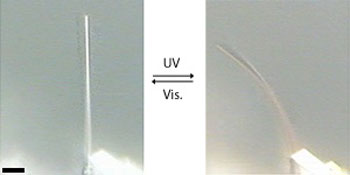| Dec 12, 2011 |
Molecular actuators: Crystals take a bow
|
|
(Nanowerk News) In chemistry, crystals have a well-deserved reputation for rigidity; the strong forces that trap molecules into three-dimensional solid states also tend to keep them immobile. However, a new discovery by researchers in Japan is set to upend these classical notions. Hideko Koshima and colleagues from Ehime University, Rigaku and RIKEN have discovered salicyclic acid derivatives that can bend reversibly on exposure to ultraviolet (UV) and visible light while still remaining crystalline ("Photomechanical bending of salicylideneaniline crystals").
|
|
The development of 'molecular machines' that convert light radiation — a versatile and easily controllable energy source — into mechanical work by transforming the structures of certain molecules is attractive for many potential applications. However, turning molecular-level shape changes into useful large-scale mechanical motions has remained extremely challenging.
|
 |
| Thin crystals of salicylideneaniline (left) curl over upon exposure to UV light (right). (© 2011 RSC)
|
|
Chemists have recently found that diarylethene crystals containing two stiff aromatic rings linked by photosensitive double bonds are excellent candidates for artificial molecular mechanical systems. When exposed to UV light, the diarylethene double bond shifts position relative to the aromatic rings, causing the molecular structure to bend. By growing long, thin crystals, these movements can cause the entire solid to flex on a macroscopic scale.
|
|
Koshima and his colleagues investigated whether a related compound, salicylideneaniline, could also undergo this type of photomechanical bending. Composed of a salicylic acid ring connected to a nitrogen-bearing aromatic ring through a carbon–nitrogen double bond, isolated salicylideneanilines readily twist in response to light exposure. To produce a solid suitable for actuating motion, the team sublimed a powder for several hours at temperatures just below the crystal's melting point. This process resulted in thin, needle-like microcrystals that grew out from the surface of a glass slide (see image).
|
|
Experiments revealed that UV light caused the salicylideneaniline crystal to bend, with movements dependent on the irradiation time. Shining visible light on the curled-over crystal caused it to straighten once more, a sequence the researchers repeated over 200 times without harming the material. Other measurements demonstrated that the salicylideneaniline actuators generated remarkable mechanical force — the team easily flipped a silica particle 50 times heavier than the microcrystal with their bendable crystal. "These findings could contribute to applications in fields ranging from medicine to manufacturing," notes Koshima.
|

